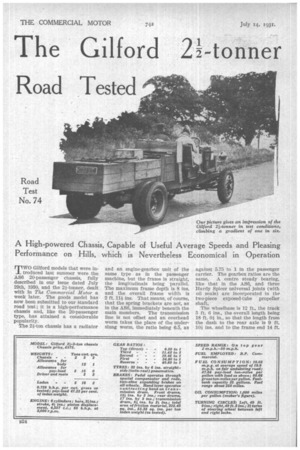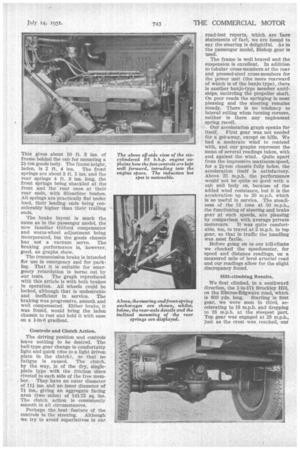The Gilford
Page 42

Page 43

Page 44

If you've noticed an error in this article please click here to report it so we can fix it.
Road Tested
A High-powered Chassis, Capable of Useful Average Speeds and Pleasing Performance on Hills, which is Nevertheless Economical in Operation
MIVO Gifford models that were in
troduced last summer were the AS6 20-passenger chassis, fully described in our issue dated July 29th, 1930, and the 21-tonner, dealt with in The Commercial Motor a week later. The goods model has now been submitted to our standard road test ; it is a high-performance chassis and, like the 20-passenger type, has attained a considerable popularity.
The 21-ton chassis has a radiator and an engine-gearbox unit of the same type as in the passenger machine, but the frame is straight, the longitudinals being parallel. The maximum frame depth is 8 ins. and the overall frame width is 2 ft. 11i ins. That means, Of course, that the spring brackets are not, as in the ASG, immediately beneath the main members, The transmission line is not offset and an overhead worm takes the place of the underslung worm, the ratio being 6.5, as against 5.75 to 1 in the passenger carrier. The gearbox ratios are the same. A centre steady bearing, like that in the AS6, and three Hardy Spicer universal joints (with oil seals) are incorporated in the two-piece exposed-tube propeller shaft, The wheelbase is 12 ft., the track 5 ft. 6 ins., the overall length being 18 ft. Olin., so that the length from the dash to the rear axle is 9 ft. 101 ins, and to the frame end 14 ft. This gives about 10 ft. 3 ins. of frame behind the cab for mounting a 2i-ton goods body. The frame height, laden, is 2 ft. 4 ins. The front springs are about 3 ft. 5 ins, and the rear springs 4 ft. 8 ins, long, the front springs being shackled at the front and the rear ones at their rear ends, with Silentbloc bushes. All springs are practically fiat under load, their leading ends being considerably higher than their trailing ends.
The brake layout is much the same as in the passenger model, the now familiar Gifford compensator and worm-wheel adjustment being incorporated, but the goods chassis has not a vacuum servo. The braking performance is, however, good, as graphs show.
The transmission brake is intended for use in emergency and for parking. That it is suitable for emergency retardation is borne out by our tests. The graph reproduced with this article is with both brakes in operation. All wheels could be locked, although that is undesirable and inefficient in service. The braking was progressive, smooth and well compensated. Either brake, it was found, would bring the laden chassis to rest and hold it with ease on a 1-in-0 gradient.
Controls and Clutch Action.
The driving position and controls leave nothing to be desired. The ball-type gear change is.comfortably light and quick (due to a light driven plate in the clutch), so that no fatigue is caused. The clutch, by the way, is of the dry, singleplate type with the friction discs riveted to each side of the free member. They have an outer diameter of 114 ins, and an inner diameter of 7?,ins., giving an aggregate facing area (two sides) of 141.75 sq. ins. The clutch action is consistently smooth in all circumstances.
Perhaps the best feature of the controls is the steering. Although we try to avoid superlatives in our road-test reports, which are hare statements of fact, we are bound to say the steering is delightful. As in the passenger model, Bishop gear is used.
The frame is well braced and the suspension is excellent. In addition to tubular cross-members at the rear and pressed-steel cross-members for the power unit (the more rearward of which is of the banjo type), there is another banjo-type member amidships, encircling the propeller shaft. On poor roads the springing is most pleasing and the steering remains steady. There is no tendency to lateral rolling when turning corners, neither is there any unpleasant spring recoil.
• Our acceleration graph speaks for itself. First gear was not needed for a get-away, except on hills. We had a moderate wind to contend with, and our graphs represent the mean of several readings taken, with and against the wind. Quite apart from the impressive maximum speed, for a 2i-ton chassis fully laden, the acceleration itself is satisfactory. Above 25 m.p.h. the performance would not be quite so good with a cab and body on, because of the added wino resistance, but it is the acceleration up to 20 m.p.h. which is so useful in service. The steadiness of the 51 tons at 50 m.p.h., the functioning of steering and brake gear at such speeds, are pleasing by comparison with average private motorcars. It was quite comfortable, too, to travel at 2 m.p.h. in top gear, so that in traffic the handling was most facile.
Before going on to our hill-climbs we checked the speedometer, for speed and distance readings, on a measured mile of level arterial road and our readings allow for the slight discrepancy found.
Hill-climbing Results.
We first climbed, in a southward direction, the 1-in-174 Brockley Hill, on the Elstree-Edgware road, which is 600 yds. long. Starting in first gear, we were soon in third, accelerating to 18 m.p.h. and dropping to 16 m.p.h, at the steepest part. Top gear was engaged at 23 m.p.h., just as the crest was reached, our time being 70 seconds and our average speed 17.5 m.p.h. Climbing this hill from the south (440 yds., averaging 1 in 11), we used second gear all the way, changing to third just before the summit was reached, the time being 74 seconds and the average speed 12.2 m.p.h.
We drove straight on into Elstree, taking the steep hill at a run at 37 m.p.h., and easily reaching the village in top gear at 22 m.p.h. We then used as a short climb Cocks Hill, on the Elstree-Barnet road. Starting in second and changing at 27 seconds to first gear, we climbed this bill in 43 seconds—the length is 200 yds., the average gradient 1 in 8.57 and the maximum 1 in 6. Our average speed was therefore 9.4 m.p.h., which is a good figure. The chassis had an ample reserve of power on the 1-in-6 gradient. Here restarting was easily effected in first gear, and nearly possible in second. The cooling-water temperature (at
the engine-block outlet pipe) was 1600 P. throughout the day, except after five or six successive timed hillclimbs, when it rose to 170° F.
Before commencing the fuel-consumption test the Zenith U-type carburetter was dismantled, the setting being found to be : choke 25, main jet 105, compensator 135, cap jet 2.5, slow-running jet 60. This setting remained unaltered throughout the day. The vehicle was brought to a marked spot on the road and the tank was then filled to the neck of the orifice. A. 46.5-mile journey was made from the Barnet by-pass through Hatfield and along main and secondary roads in the Hertford district, the circuit terminating at the starting point. The speed averaged just below 20 m.p.h., and the fuel consumption worked out at the rate of 10.05 m.p.g., which, considering the power and performance, is a satisfactory figure and one which would be bettered on a long main-road journey.




































































































